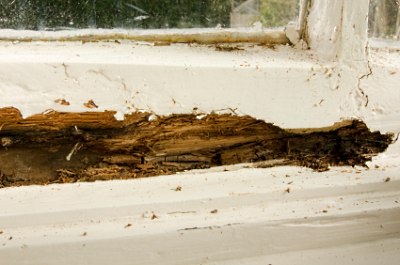Damaged wood must be repaired before refinishing it. Not only will your paint job look bad when applied over the damage, but if the wood has water-damage or severe rot, the paint will not adhere properly.
Before you repair the damaged wood, you must find and eliminate the source of the leak, which could possibly be a gutter or downspout. Once you’ve resolved the issues that caused damage in the first place, you can move forward with repairing the damage.
If it is a window sill or molding that has been leaking, it is sometimes easier to replace the entire window frame than to repair the sill or molding, especially if the damage is extensive. Evaluate how extensive the damage actually is. And determine if the wood is dry or wet.
There are many types of wood putty available that can repair minor damage. There are also epoxy wood fillers that can be applied very thick and replace damaged or missing wood.
One of the best ways to fill rotted wood involves using a wood hardener— a thin liquid preparation used for stabilizing dry rot damaged wood as long as the wood is dry. Wet wood doesn’t absorb the penetrating compound. This is poured on the wood to harden it, followed by an application of epoxy wood filler. The epoxy is stronger than wood and once cured, can be sanded, drilled, primed, and painted.
To use epoxy to repair the damaged woods use the following steps.
Stabilize the Rot with an Epoxy Wood Hardener
Dry rot and other types of spongy damaged wood needs stabilizing before any repairs can happen. An is a thin epoxy compound that is specifically designed to penetrate rot and become a hard foundation for the epoxy wood putty.
Remove any flaky rotted wood, the remaining spongy wood can remain. If the rot is very thick or in a vertical surface; small holes can be drilled into the wood, 1-2 inches apart until you reach solid wood, to help with penetration and anchoring the new repair.
Mix the 2-comounents (part A & B) according to directions then begin saturating the wood. Application can be with a chip brush for working overhead or poured directly onto the rot. A used turkey baster can be used for more control. Wait for each application to penetrate then repeat until no more can be taken into the rotted wood. The epoxy compound will remain a workable viscous liquid for about 1 hour.
Allow to dry and harden overnight before continuing with the patching.
Mix the Epoxy Wood Filler
The epoxy needs to be mixed on a board according to the manufacturer’s instructions—usually one part resin to one part hardener. Epoxy works by heat reaction, so you will not need to mix much of it. If you mix too much, the epoxy can build up heat and harden before you can use it.
Apply the Epoxy Wood Filler
The can be applied in layers for vertical repairs. For horizontal repairs most epoxy wood fillers can be applied at any thickness and are non-shrinking.
Using a putty knife, apply the epoxy filler to the damaged area of the wood. Work quickly, once the epoxy begins to harden you will not be able to spread it. Average working time is about 30 minutes for most epoxies.
Shape the Wood Filler
You will shape the epoxy with a putty knife until it matches the form of the original wood. Once it begins to harden, stop working.
Once the epoxy has cured completely sand it to shape. If necessary, use a chisel or planer to shave the cured epoxy.
You are now ready to prime and paint the damaged wood section. If you take your time with shaping and smoothing the repaired area so it blends into the surrounding wood, no one will ever know there was damage.




